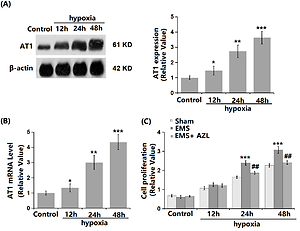Current issue
Archive
Manuscripts accepted
About the Journal
Editorial office
Editorial board
Section Editors
Abstracting and indexing
Subscription
Contact
Ethical standards and procedures
Most read articles
Instructions for authors
Article Processing Charge (APC)
Regulations of paying article processing charge (APC)
OBSTETRICS AND GYNAECOLOGY / RESEARCH PAPER
The protective effects of Azilsartan against hypoxia in endometrial stromal cells: an implication in endometriosis
1
General Hospital of Ningxia Medical University, China
2
the Second People’s Hospital of Yinchuan, China
3
People’s Hospital of Ningxia, China
Submission date: 2022-04-20
Final revision date: 2022-05-30
Acceptance date: 2022-07-02
Online publication date: 2022-07-19
KEYWORDS
TOPICS
ABSTRACT
Introduction:
Endometriosis is a reproductive disorder closely associated with hypoxia stress. Increasing evidences have implied the important roles of angiotensin II (ANG II) receptors in the pathophysiology of endometriosis. Thus, we speculated that Azilsartan (AZL), an ANG II receptor blocker, might have an effective function in controlling endometriosis.
Material and methods:
The endometriotic animal model was established in female SD rats (6-8 weeks old, 200-220 g). Rats were divided into sham group and endometriosis (EMS) group. Rats in EMS group were anaesthetized by halothane and a mid-ventral incision was performed to expose the bowels. Human endometrial stromal cell line T-HESC was used for the in vitro assays. The T-HESC cells were cultured in DMEM-F12 mediumwith 10% fetal bovine serum (FBS, Hyclone), and 4 mM L-glutamine, 0.25% HEPES plus necessary antibiotics (Sigma-Aldrich, USA), at 37°C in a humidified atmosphere of 5% CO2.
Results:
The results show that upregulation of ANG II type 1 (AT1) receptor was observed in the endometriotic rat models. Treatment with AZL prevented the development of endometriotic lesions and suppressed the expressions of HIF-1α and cyclooxygenase 2 (COX-2) in endometriotic rats. In vitro assays proved that hypoxia-induced proliferation, migration, and invasion of T-HESC cells were attenuated by AZL. AZL inhibited the expression levels of hypoxia-inducible factor-1α (HIF-1α), COX-2, and prostaglandin E2 (PGE2) production in hypoxia-induced T-HESC cells. Overexpression of HIF-1α blocked the effects of AZL on T-HESC cells in response to hypoxia.
Conclusions:
AZL showed therapeutic function on endometriosis through inhibiting hypoxia-induced cell proliferation, migration, and invasion of T-HESC cells via HIF-1α/COX-2/PGE2 signaling.
Endometriosis is a reproductive disorder closely associated with hypoxia stress. Increasing evidences have implied the important roles of angiotensin II (ANG II) receptors in the pathophysiology of endometriosis. Thus, we speculated that Azilsartan (AZL), an ANG II receptor blocker, might have an effective function in controlling endometriosis.
Material and methods:
The endometriotic animal model was established in female SD rats (6-8 weeks old, 200-220 g). Rats were divided into sham group and endometriosis (EMS) group. Rats in EMS group were anaesthetized by halothane and a mid-ventral incision was performed to expose the bowels. Human endometrial stromal cell line T-HESC was used for the in vitro assays. The T-HESC cells were cultured in DMEM-F12 mediumwith 10% fetal bovine serum (FBS, Hyclone), and 4 mM L-glutamine, 0.25% HEPES plus necessary antibiotics (Sigma-Aldrich, USA), at 37°C in a humidified atmosphere of 5% CO2.
Results:
The results show that upregulation of ANG II type 1 (AT1) receptor was observed in the endometriotic rat models. Treatment with AZL prevented the development of endometriotic lesions and suppressed the expressions of HIF-1α and cyclooxygenase 2 (COX-2) in endometriotic rats. In vitro assays proved that hypoxia-induced proliferation, migration, and invasion of T-HESC cells were attenuated by AZL. AZL inhibited the expression levels of hypoxia-inducible factor-1α (HIF-1α), COX-2, and prostaglandin E2 (PGE2) production in hypoxia-induced T-HESC cells. Overexpression of HIF-1α blocked the effects of AZL on T-HESC cells in response to hypoxia.
Conclusions:
AZL showed therapeutic function on endometriosis through inhibiting hypoxia-induced cell proliferation, migration, and invasion of T-HESC cells via HIF-1α/COX-2/PGE2 signaling.
Share
RELATED ARTICLE
We process personal data collected when visiting the website. The function of obtaining information about users and their behavior is carried out by voluntarily entered information in forms and saving cookies in end devices. Data, including cookies, are used to provide services, improve the user experience and to analyze the traffic in accordance with the Privacy policy. Data are also collected and processed by Google Analytics tool (more).
You can change cookies settings in your browser. Restricted use of cookies in the browser configuration may affect some functionalities of the website.
You can change cookies settings in your browser. Restricted use of cookies in the browser configuration may affect some functionalities of the website.



